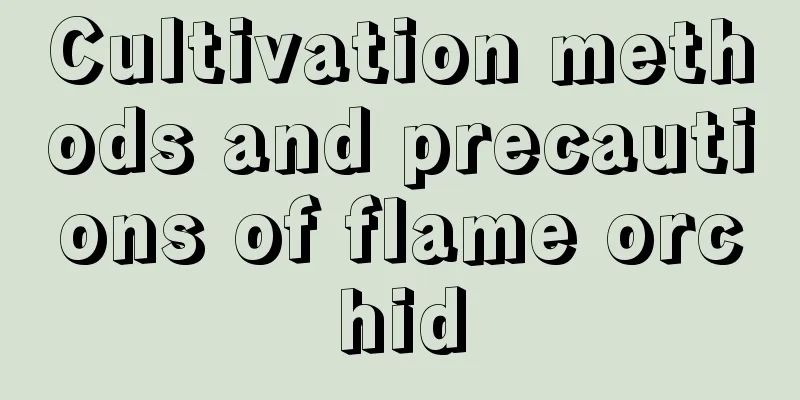Cultivation methods and precautions of flame orchid

1. Maintenance methods1. Temperature: Judging from the latitude of its distribution area, it prefers higher temperatures. Specifically, the most suitable range is between eighteen and thirty-five degrees. Its cold resistance is not very good, so it is generally not distributed in places with severe winters. If you need to maintain it, you need to pay attention to protecting it from the cold in winter. 2. Light: Flame orchid is a light-loving plant. Its growth and subsequent flowering cannot be separated from light. However, it should be noted that too strong light can also be harmful, such as causing leaves to turn yellow and fall off, and flowers to wither, so it is necessary to provide some shade at noon. 3. Watering: Flame orchid likes moisture. Especially when it is growing vigorously, it needs a lot of water. In addition to keeping the substrate moist, the air humidity range must be adjusted to between seventy and eighty percent. When it is too dry, spray water to adjust it. 4. Fertilization: Flame orchid requires more fertilizer. In addition to the general base fertilizer, fertilizer should be applied every half a month. Especially during the flowering period, phosphorus and potassium fertilizers are more critical. 2. Breeding techniques1. Reproduction: It can be propagated by division. It is mainly carried out in spring and autumn. You can choose the new shoots that grow after removing the top of the mother plant as materials. After cutting them with a knife, they can be planted. Overall, the operation method is relatively simple and the chance of success is relatively high. However, special attention should be paid to maintenance after planting to ensure the temperature and humidity. 2. Pruning: In spring, the main pruning task is topping, and the yellow and dry leaves also need to be cut off. Furthermore, it is best to cut off the remaining flowers in time after flowering. 3. Problem diagnosis and treatment1. Diseases: Overall, there are not too many diseases. In summer, the probability of occurrence is relatively higher. For example, "white rot" is prone to occur under high temperature and high humidity conditions. Lime can be used for prevention and control. In addition, drainage must be done properly. 2. Pests: The most commonly seen ones are "scale insects", which are more likely to appear when the humidity is high and can be controlled with pesticides. IV. Other issues1. Toxicity: Flame orchid is non-toxic and harmless. 2. Can it be raised at home? Yes, it has good ornamental value. However, this species is relatively rare and not very common. |
<<: Huang Qiuying's breeding methods and precautions
>>: Cultivation methods and precautions of ice berry
Recommend
How to improve the survival rate of rose cuttings
Selection of cutting ears When cutting cuttings, ...
What are the succulent varieties that are more beautiful when it is colder?
Maiden Heart The total height of the plant is bet...
What are the plants with special abilities?
1. Dancing Grass As the name suggests, dancing gr...
Do Impatiens need watering every day?
Do you water Impatiens every day? Impatiens does ...
How to care for cineraria in winter
Keep the humidity level of Cineraria at the right...
Tips for fertilizing flowers
Types of Fertilization Organic fertilizer It is a...
How to grow boxwood
1. Breeding environment 1. Soil: To grow boxwood ...
Dandelion disease control
Common diseases of dandelions Leaf spot Initially...
Can the newly transplanted osmanthus tree be pruned (how to prune the newly planted osmanthus tree potted plant)
In fact, the purpose of pruning potted osmanthus ...
Can coconut trees be planted in Guangxi?
Can coconut trees be grown in Guangxi? Coconut tr...
How to breed the Tower of Akane
The propagation method of the tower of Akane: div...
When to transplant osmanthus trees
Transplanting osmanthus trees cannot be done at a...
When is the best time to sow cactus seeds?
Cactus seed sowing time When sowing cactus seeds,...
Does pepper tree prefer shade or sun?
Does pepper tree prefer shade or sun? Pepperwood ...
The efficacy and function of gourd
effect Gourd is a plant that does not have high e...









